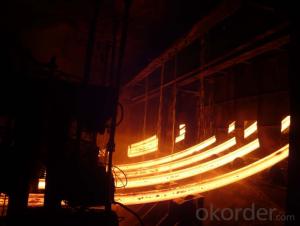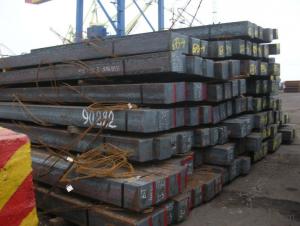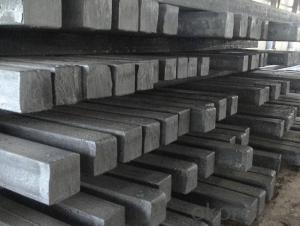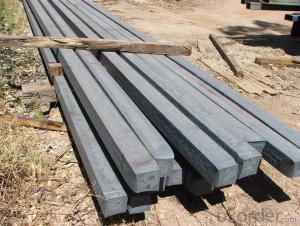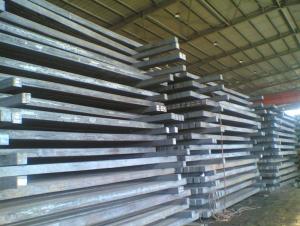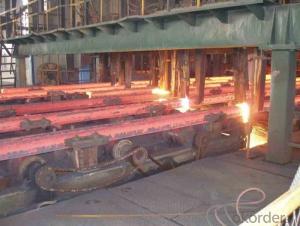Hot Rolled Square Steel Billet 3SP Standard 175mm
- Loading Port:
- Shanghai
- Payment Terms:
- TT OR LC
- Min Order Qty:
- 2000 m.t.
- Supply Capability:
- 10000 m.t./month
OKorder Service Pledge
OKorder Financial Service
You Might Also Like
Structure of Hot Rolled Square Steel Billet 3SP Standard 175mm

Description of Hot Rolled Square Steel Billet 3SP Standard 175mm
PPGI is made by cold rolled steel sheet and galvanized steel sheets as baseplate, through the surface pretreatment (degreasing, cleaning, chemical conversion processing), coated by the method of continuous coatings (roller coating method),
and after roasting and cooling. Zinc coating: Z60, Z80, Z100, Z120, Z180, Z275, G30, G60, G90
Alu-zinc coating: AZ60, AZ80, AZ100, AZ120, AZ180, G30, G60, G90
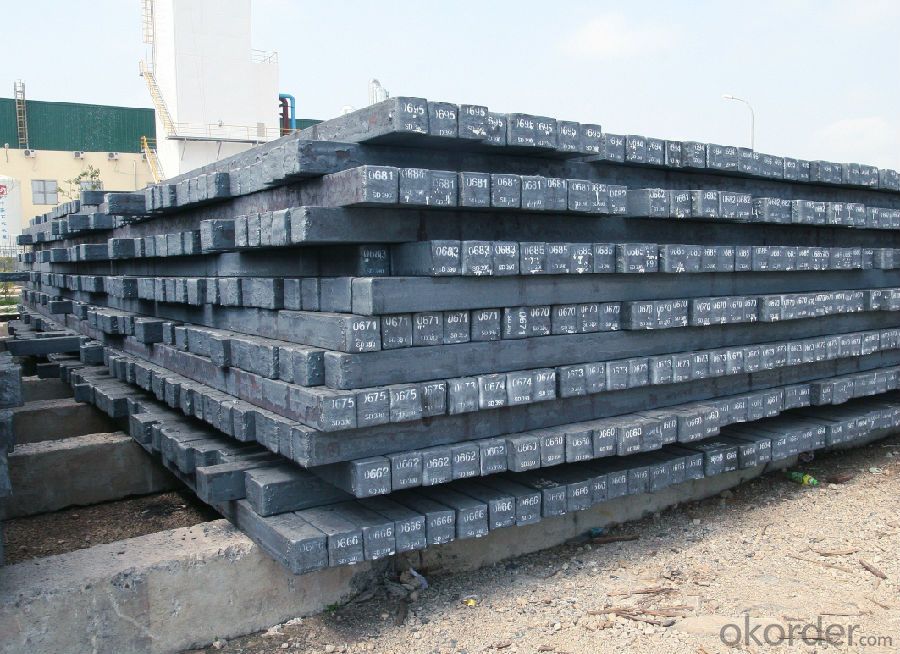
Main Feature of Hot Rolled Square Steel Billet 3SP Standard 175mm
1) Excellent corrosion resistance: The zinc layer provides a good protection of Pre-painted Galvanizeed Steel Sheet.
2) High heat resistance: The reflective surface of the material aids in efficiently reflecting the sunlight away and in turn reducing the amount of heat transmitted. The thermal reflectivity converts into energy savings.
3) Aesthetics: Pre-Painted Galvanized steel sheet is available in plethora of patterns and multiple sizes as per the requirements that given by our customers.
4) Versatility: can be used in the various areas.Standard seaworthy export packing: 3 layers of packing, inside is kraft paper, water plastic film is in the middle and outside GI steel sheet to be covered by steel strips with lock, with inner coil sleeve.
Applications of Hot Rolled Square Steel Billet 3SP Standard 175mm
1) Automotive bodies: filters, fuel tanks, etc.
2) Construction materials: roofings, welding pipes,
3) Electric and electronic appliances: computer cans, etc.
4) Steel cans: containers, etc.
5) Steel furniture: washing machines, refrigerators, microwaves, etc.
6) Drums
7) Office equipment: printer, recorders, etc.
8) Motors and transformers
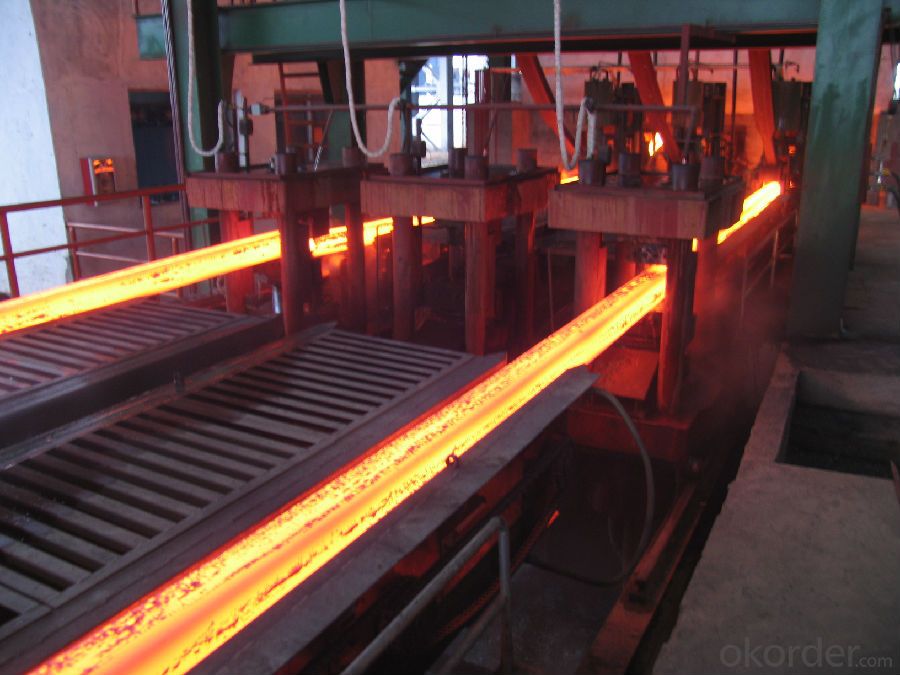
Specifications of Hot Rolled Square Steel Billet 3SP Standard 175mm
| Classified symbol | Yield Point Minimum N/mm2 | Tensile Strength Minimum | Elongation Minimum % | Application | ||||
| N/mm2 | Nominal Thickness mm (t) | |||||||
| JIS | Yogic | 0.25-0.4 | 0.4-0.6 | 0.6-1.0 | 1.0-1.6 | |||
| G3312 | specification | |||||||
| CGCC | CGCC | -205 | -270 | -20 | -21 | -24 | -24 | Commercial |
| CGCD | CGCD | --- | 270 | --- | 27 | 31 | 32 | Drawing |
| --- | CG340 | 245 | 340 | 20 | 20 | 20 | 20 | Structural |
| CGC400 | CG400 | 295 | 400 | 16 | 17 | 18 | 18 | Structural |
| CGC440 | CG440 | 335 | 440 | 14 | 15 | 16 | 18 | Structural |
| CGC490 | CG490 | 365 | 490 | 12 | 13 | 14 | 16 | Structural |
| CGC570 | CG570 | 560 | 570 | --- | --- | --- | --- | Structural |
| ASTM Designation | Yield Point Minimum | Tensile Strength Minimum | Elongation Minimum % | Application | Q/BQB 445-2004(China standard) | ASM A653/A653M | JISG 3312 | |
| ksi(MPa) | ksi(MPa) | TDC51D+Z | (CS TYPE A+Z) | CGCC | ||||
| A653(M)-99 CS TYPE A,B,C | --- | --- | --- | Commercial | TDC52D+Z | CGCD | ||
| A653(M)-99 FS | --- | --- | --- | Lock Forming | TS250GD+Z | (G250+Z) | - | |
| A653(M)-99 DS | --- | --- | --- | Drawing | TS300GS+Z | (G300+Z) | CGC 400 | |
| A653(M)-99 SS Grade33(230) | 33(230) | 45(310) | 20 | Structural | TS350GD+Z | (G350+Z) | CGC490 | |
| A653(M)-99 SS Grade37(255) | 37(255) | 52(360) | 18 | Structural | TS550GD+Z | (G550+Z) | CGC570 | |
| A653(M)-99 SS Grade40(275) | 40(275) | 55(380) | 16 | Structural | ||||
| A653(M)-99 SS Grade50(345) | 50(345) | 65(450) | 12 | Structural | ||||
| A653(M)-99 SS Grade80(550) | 80(550) | 82(570) | --- | Structural | ||||
FAQ of Hot Rolled Square Steel Billet 3SP Standard 175mm
We have organized several common questions for our clients,may help you sincerely:
1. How Can I Visit There?
Our company is located in Tianjin City, China, near Beijing. You can fly to Tianjin Airport Directly. All our clients, from home or aboard, are warmly welcome to visit us!
2. How Can I Get Some Sample?
We are honored to offer you sample.
3. Why choose CNBM?
1, ISO, BV, CE, SGS approved.
2, Competitive price and quality.
3, Efficient service team online for 24 hours.
4, Smooth production ability(50000tons/month) .
5, quick delivery and standard exporting package.
6, Flexible payment with T/T, L/C, Paypal, Kunlun bank, etc.
- Q:What are the potential safety risks associated with handling steel billets?
- There are several safety risks that need to be considered when handling steel billets. Firstly, the weight of these billets can be significant, and if they are not lifted or carried properly, it can result in musculoskeletal injuries like strains and sprains. To minimize the chances of these injuries, it is crucial to use the correct equipment and lifting techniques. Another risk to be aware of is the sharp edges and corners of steel billets. Inadequate handling can lead to lacerations or puncture wounds. To reduce this risk, it is advisable to wear cut-resistant gloves or other appropriate personal protective equipment. Furthermore, steel billets can be hot to the touch, especially if they have recently undergone processing or manufacturing. Coming into contact with hot billets can cause burns or thermal injuries. Therefore, it is important to wear heat-resistant gloves or other protective gear when handling them. In addition, heavy machinery like cranes or forklifts is often used to transport steel billets. Operating these machines without proper training or supervision can result in accidents such as collisions, falling objects, or equipment overturning. To minimize these risks, it is essential to receive adequate training, follow safety protocols, and maintain clear communication. Lastly, steel billets may contain hazardous chemical coatings or residues that can be harmful if ingested, inhaled, or come into contact with the skin. It is crucial to be aware of any potentially hazardous substances present on the billets and take appropriate precautions, such as wearing protective clothing, gloves, and respiratory equipment if necessary. Overall, handling steel billets poses several safety risks, including musculoskeletal injuries, lacerations or puncture wounds, burns or thermal injuries, accidents involving heavy machinery, and exposure to hazardous substances. To ensure a safe working environment, it is important to follow proper safety procedures, use appropriate protective equipment, and receive comprehensive training.
- Q:How are steel billets handled during transportation?
- Steel billets are typically handled with great care during transportation to ensure their safety and prevent any damage. They are usually transported using specialized equipment such as cranes, forklifts, or conveyors. These tools are used to lift and move the heavy billets from one location to another. Before transportation, the billets are often bundled or secured together to prevent them from shifting or falling during transit. This bundling process can involve using steel straps or bands to hold the billets tightly together, ensuring they remain stable and intact during transportation. In addition to securing the billets, protective measures are often taken to prevent any external damage. For instance, the billets may be covered with protective coatings, such as oil or rust inhibitors, to shield them from moisture or corrosion. This is particularly important when transporting billets over long distances or in adverse weather conditions. During transportation, the billets are carefully loaded onto trucks, trains, or ships, depending on the destination. Special attention is given to balancing the weight distribution to prevent any imbalance or tipping during transit. The transportation vehicles used are designed to handle heavy loads and often have mechanisms in place to secure the billets further, such as straps, latches, or containers. While in transit, the vehicles carrying the steel billets are driven or operated with caution to minimize any sudden movements or impacts. Drivers may need to follow specific routes or speed limits to ensure a smooth and safe journey. Regular inspections and maintenance of the transportation vehicles are conducted to ensure their reliability and prevent any mechanical failures that could jeopardize the safety of the billets. Overall, the transportation of steel billets involves a combination of careful planning, secure bundling, protective measures, and safe handling techniques. These practices aim to safeguard the billets and ensure they reach their destination in optimal condition, ready for further processing or use in various industries.
- Q:How are steel billets used in the production of rebar?
- The production of rebar relies heavily on steel billets, which serve as a vital raw material. Rebar, or reinforcing bar, is a form of steel reinforcement that is utilized in concrete structures for added strength and stability. The process of manufacturing rebar commences with the creation of steel billets. Steel billets are solid, semi-finished steel products that typically exhibit a square or rectangular shape. They are generated through the casting procedure, in which molten steel is poured into molds and allowed to solidify. Once solidified, the billets are prepared for use in various applications, including the production of rebar. To produce rebar, the steel billets are initially heated to a high temperature within a furnace. This stage, known as hot rolling, renders the steel malleable and pliable. The heated billets are then passed through a sequence of rolling mills, where they are shaped into elongated, cylindrical rods with specific diameters. Throughout the rolling process, the steel billets endure immense pressure and heat, resulting in the alignment of the steel grains and an increase in strength. The rods are continuously rolled until they attain the desired dimensions and lengths. Once the rolling process is completed, the rods undergo cooling and are subsequently cut into standardized lengths for the purpose of being sold as rebar. The resulting rebar is a robust and enduring steel reinforcement that finds extensive usage in construction projects. It is commonly embedded within concrete structures, such as buildings, bridges, and highways, in order to enhance their capacity to bear weight and withstand tension and bending forces. The utilization of rebar assists in the prevention of cracking and failure of concrete structures, thereby ensuring their long-term durability and safety. In conclusion, steel billets play a critical role in the production of rebar as they undergo transformation via the hot rolling process, ultimately becoming elongated, cylindrical rods. These rods, once cooled and cut, serve as an indispensable reinforcement element within concrete structures, providing strength and stability to the overall construction.
- Q:What are the common applications of steel billets?
- Steel billets are commonly used as raw material for the production of various steel products, such as bars, rods, wire, pipes, and tubes. They are also utilized in the automotive industry for manufacturing parts like crankshafts, camshafts, and gears. Additionally, steel billets find applications in construction for producing structural elements like beams, columns, and girders.
- Q:What are the different steelmaking processes used for producing steel billets?
- Steel billets can be produced using various steelmaking processes, each with its own advantages and limitations. These processes differ in terms of efficiency, cost-effectiveness, and the quality of the steel they produce. Some commonly used processes for steel billet production include: 1. Electric Arc Furnace (EAF): By melting recycled steel scrap using an electric arc, the EAF process offers flexibility and the ability to produce steel with different compositions. It is also considered environmentally friendly. 2. Basic Oxygen Furnace (BOF): The BOF process involves blowing oxygen into molten iron to remove impurities and control steel composition. It is commonly used for high-volume steel production and is known for its high productivity. 3. Induction Furnace: Through electromagnetic induction, the induction furnace process efficiently heats steel scrap. It is commonly used for small-scale steel production and offers precise temperature control. 4. Continuous Casting: Molten steel is poured into a water-cooled mold in the continuous casting process, resulting in solidified billets. This process boasts high production rates and consistent steel quality. 5. Ingot Casting: Molten steel is poured into molds to create ingots in the ingot casting process, which can later be processed into billets. While less commonly used due to lower efficiency and quality compared to continuous casting, it still has specific applications. The choice of steelmaking process depends on factors such as desired steel quality, production volume, cost considerations, and environmental impact. Steel producers carefully select the most suitable process based on their specific requirements.
- Q:What are the different types of steel billet inspection equipment?
- There are several types of steel billet inspection equipment, including ultrasonic testing machines, magnetic particle inspection systems, eddy current testing devices, and visual inspection tools. These equipment are used to ensure the quality and integrity of steel billets by detecting any defects or irregularities in their composition, surface, or internal structure.
- Q:What are the common defects in billet? What's the cause?
- Five, X ray inspection, porosity, ultrasonic testing:One, 5, magnetic particle inspection, the back of the dent; 6, overheating and over burning: 1, penetrant inspection;Four. 2. The size of the weld does not meet the requirements and slag inclusion; 3 high-energy X-ray inspection, lamellar tearing and R ray flaw detection; 2;Five;Two: 1, arc crater;Methods for inspection of weld defects;
- Q:How are steel billets used in the manufacturing of shipbuilding parts?
- Steel billets are used in the manufacturing of shipbuilding parts as they serve as the primary raw material for shaping and forming various components. These billets are heated and then passed through a series of rolling processes to produce different shapes, such as plates, beams, and angles, which are essential for constructing the hull, decks, and structural components of ships. The strength and durability of steel billets make them ideal for withstanding the harsh conditions at sea, ensuring the integrity and longevity of shipbuilding parts.
- Q:How are steel billets used in the manufacturing of pressure vessels?
- Pressure vessels require steel billets as a necessary part of their manufacturing process. These metal products are in a semi-finished state and are typically made through casting or extrusion. The billets are molded into a solid square or rectangular shape to ensure consistent and uniform material for further processing. To initiate the manufacturing process, the steel billets are heated to a specific temperature, making them more malleable and easier to handle. Once heated, they are placed into a forging machine, where intense pressure and shaping take place. This forging process effectively eliminates any defects or inconsistencies in the billet's structure, resulting in a stronger and more durable material. After the forging stage, the steel billets undergo additional processing using different techniques like rolling or machining. These techniques are employed to achieve the desired dimensions and shape required for pressure vessel fabrication. By refining the billet's surface finish and improving its mechanical properties, these techniques enhance the overall quality of the billet. Once the billets have been shaped and processed, they are cut into smaller sections that serve as the foundation for constructing pressure vessels. These sections are welded together to form the vessel's shell, ensuring a secure and tight seal to contain high-pressure fluids or gases. The use of steel billets in pressure vessel manufacturing is critical due to their superior strength, durability, and resistance to high-pressure environments. The uniformity and consistency of the billets provide a reliable material for fabricating vessels that can endure extreme conditions, guaranteeing the safety and integrity of the contents within. In conclusion, steel billets play a crucial role in the manufacturing of pressure vessels by providing the core components for constructing the vessel's shell. Through a series of heating, forging, and processing techniques, the billets are transformed into robust and enduring sections that are then welded together to form the final vessel. The utilization of steel billets ensures the structural integrity and dependability of pressure vessels, making them suitable for a wide range of industrial applications.
- Q:What are the potential applications of steel billets in the transportation industry?
- In the transportation industry, steel billets offer a wide range of potential applications. One important use is their role in manufacturing various parts and components for automobiles, including engine blocks, chassis, suspension systems, and wheels. These critical components require the strength and durability that steel billets provide, ensuring the safety and reliability of vehicles. Furthermore, steel billets are commonly employed in the production of railway tracks, guaranteeing the stability and longevity of rail infrastructure. Their high strength and resistance to wear and tear make them an ideal choice, enabling them to withstand heavy loads and extreme weather conditions. Additionally, steel billets find application in ship and boat construction. The marine industry relies on their strength and corrosion resistance to build hulls, decks, and various structural components. Steel billets also play a crucial role in bridge construction, providing the necessary strength and structural integrity to support heavy traffic loads. Moreover, steel billets are extensively used in the manufacturing of aircraft parts and components. The aviation industry demands materials with an exceptional strength-to-weight ratio, and steel billets meet this requirement. They are utilized in the production of landing gear, engine mounts, and other critical aircraft structures. In summary, the potential applications of steel billets in the transportation industry are vast and diverse. Their strength, durability, and resistance to wear and tear make them indispensable for the production of parts and components in automobiles, railway tracks, ships, boats, aircraft, and bridges. Steel billets contribute to the safety, reliability, and efficiency of transportation systems, making them an essential material in this industry.
1. Manufacturer Overview |
|
|---|---|
| Location | |
| Year Established | |
| Annual Output Value | |
| Main Markets | |
| Company Certifications | |
2. Manufacturer Certificates |
|
|---|---|
| a) Certification Name | |
| Range | |
| Reference | |
| Validity Period | |
3. Manufacturer Capability |
|
|---|---|
| a)Trade Capacity | |
| Nearest Port | |
| Export Percentage | |
| No.of Employees in Trade Department | |
| Language Spoken: | |
| b)Factory Information | |
| Factory Size: | |
| No. of Production Lines | |
| Contract Manufacturing | |
| Product Price Range | |
Send your message to us
Hot Rolled Square Steel Billet 3SP Standard 175mm
- Loading Port:
- Shanghai
- Payment Terms:
- TT OR LC
- Min Order Qty:
- 2000 m.t.
- Supply Capability:
- 10000 m.t./month
OKorder Service Pledge
OKorder Financial Service
Similar products
New products
Hot products
Related keywords
